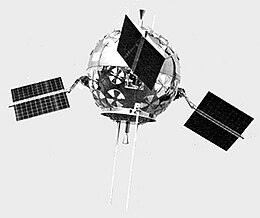Pioneer P-1: Difference between revisions
Content deleted Content added
No edit summary |
No edit summary |
||
| Line 3: | Line 3: | ||
| name = Pioneer P-1 |
| name = Pioneer P-1 |
||
| image = File:Pioneer P-1 P-3 P-30 P-31.jpg |
| image = File:Pioneer P-1 P-3 P-30 P-31.jpg |
||
| image_size = 120px |
|||
| image_caption = The Lunar Probe Pioneer P-1. |
| image_caption = The Lunar Probe Pioneer P-1. |
||
Revision as of 00:51, 6 January 2020
 The Lunar Probe Pioneer P-1. | |
| Mission type | Lunar Orbiter |
|---|---|
| Operator | |
| COSPAR ID | 1959-E02 |
| Mission duration | Failure to launch |
| Spacecraft properties | |
| Manufacturer | |
| Launch mass | 88.4 kilograms (195 lb) |
| Dry mass | 25.3 kilograms (56 lb) |
| Start of mission | |
| Launch date | 24 September 1959, 05:44:52 UTC |
| Rocket | Atlas C-Able |
| Launch site | Cape Canaveral, LC-12 |
Pioneer P-1 was a failed mission in the Pioneer program. The spacecraft was a 1-meter diameter sphere, with a propulsion module. It was launched on 24 September 1959 on an Atlas C-Able launcher. It was to carry a TV camera and a magnetic field sensor. It was to be spin-stabilized and was known as a 'paddlewheel' spacecraft. The Atlas-Able launch vehicle was destroyed in an explosion on the launch pad at Cape Canaveral during a pre-launch static firing. The payload of P-1 spacecraft and Able IV space engine was not present on the launch vehicle when it exploded, and the payload was later used in the P-3 mission.[1][2]

References
- ^ Gunter's Space Page - information on Pioneer P-1
- ^ New York Times, "U.S. Moon Rocket Blows Up in Test", Sept 25, 1959

